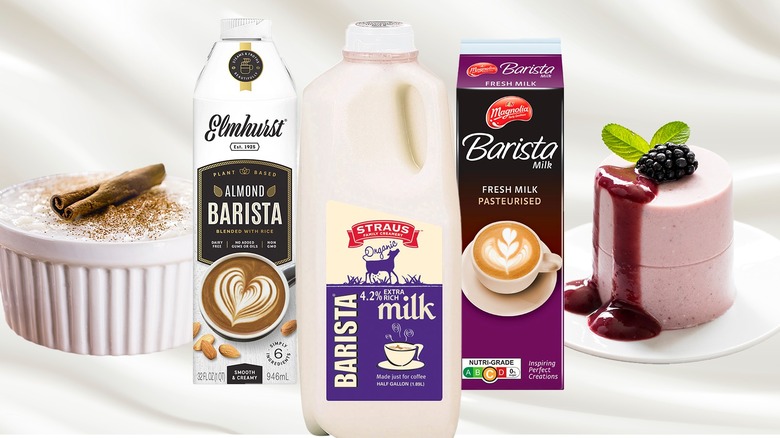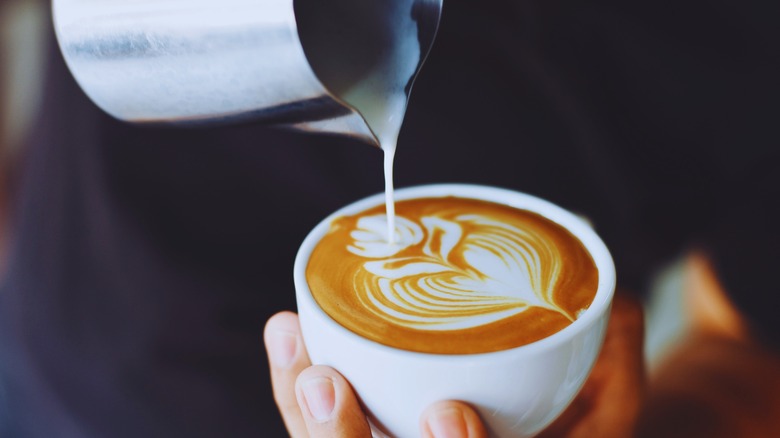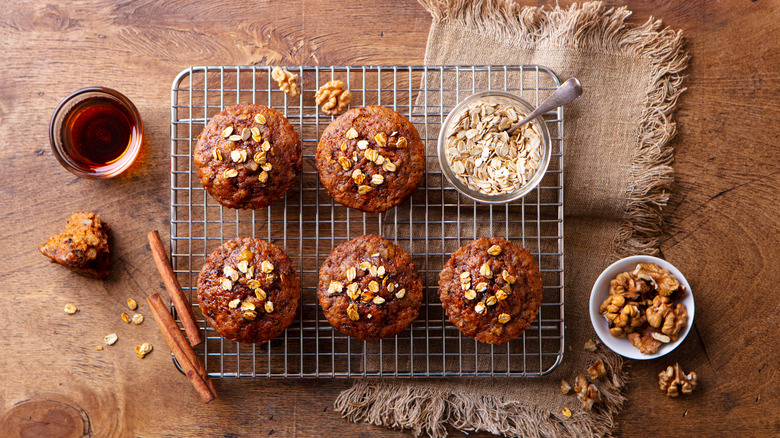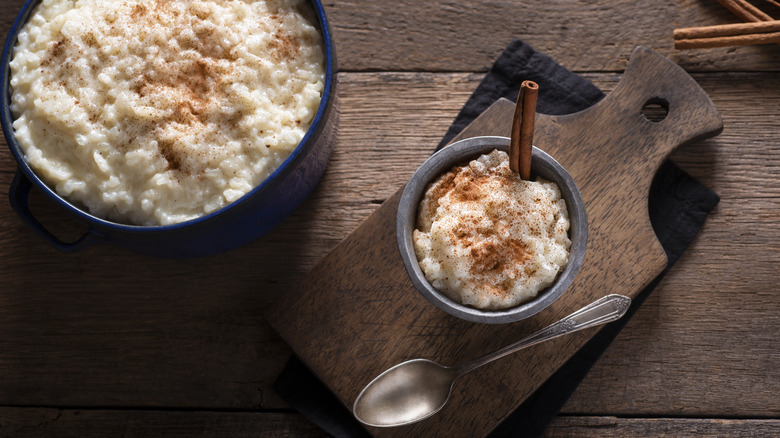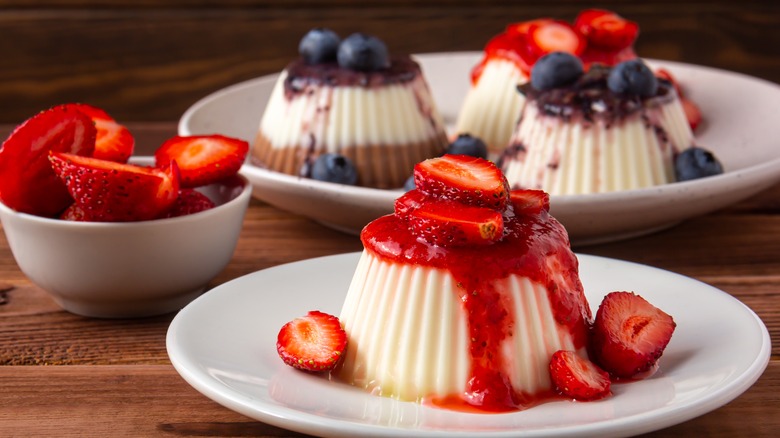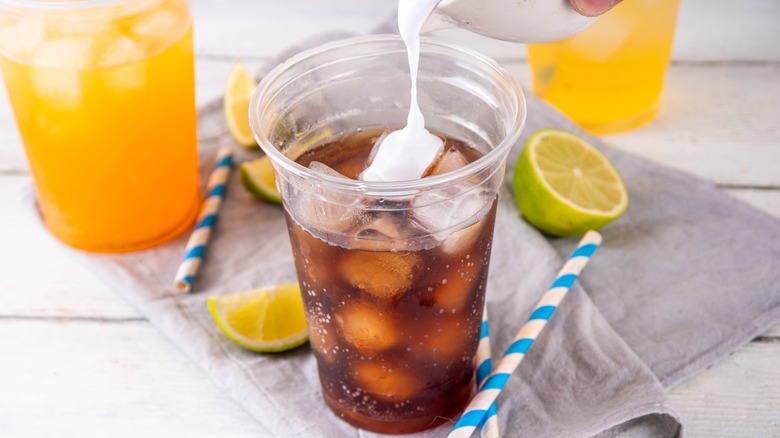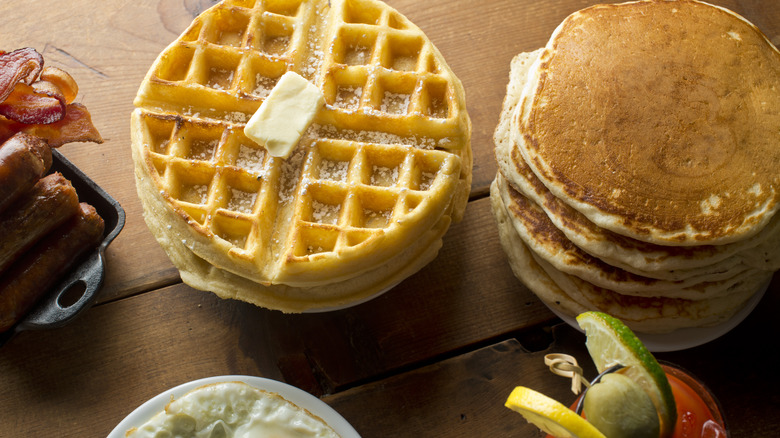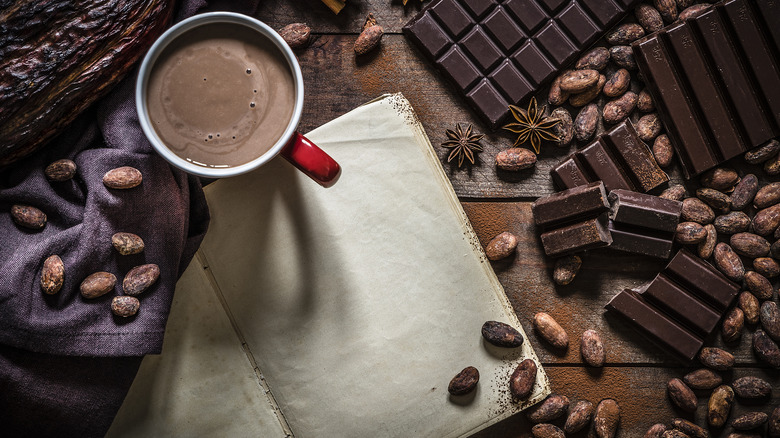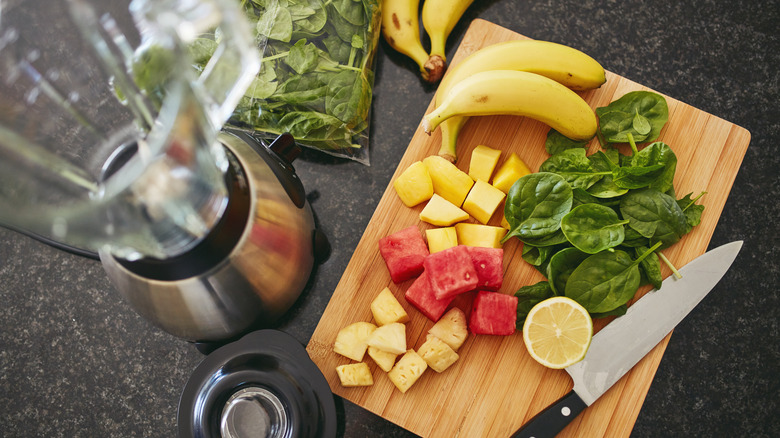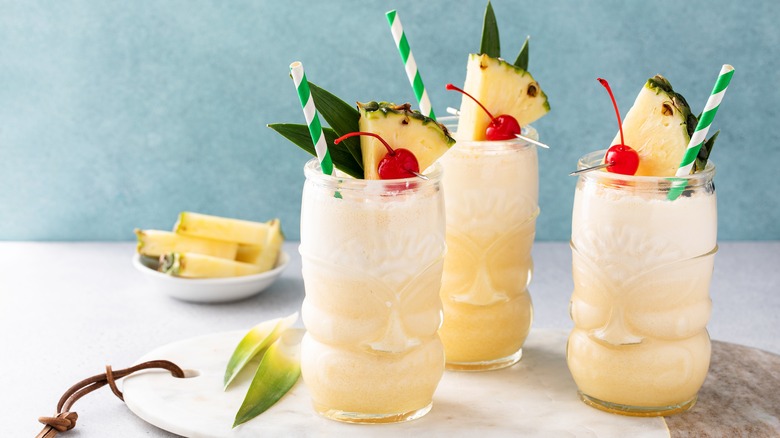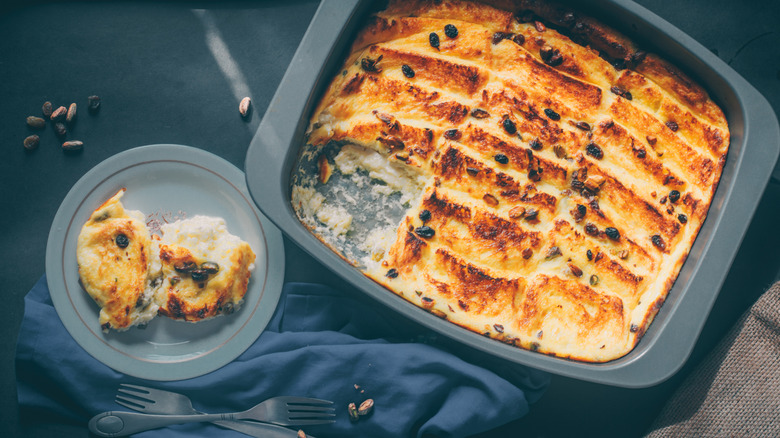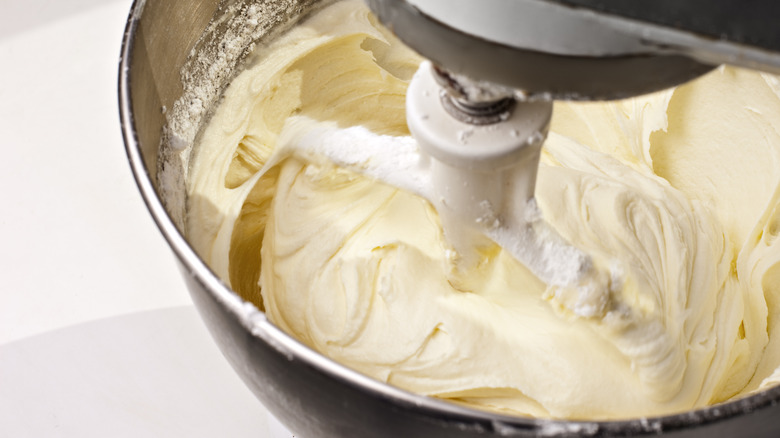10 Ways To Use Barista Milk For More Than Coffee, According To A Recipe Developer
Remember when milk referred to full-fat dairy milk? Maybe you even remember when milk was delivered to your home in bottles with a thick layer of cream on top. Well, now when you ask for milk, you might need to review a menu of options ranging from almond or oat to lactose-free. As a restaurant chef turned recipe developer, I have witnessed milk choices, dairy and non-dairy, explode, and the good news is that it means there is less of a barrier for people with dietary restrictions or personal preferences. But not all milks are the same, or work the same in a recipe. If you have ever had a cup of coffee with curdled non-dairy milk, you know what I'm talking about.
Some milks work better than others in different applications, and one of the most versatile milks is barista milk. I lived (and cooked) dairy-free for about three years, and one of the biggest challenges was finding a non-dairy milk that visually and texturally lightened my coffee. These were pre-barista milk days, and having compared a barista milk to a regular milk, I can tell you it is a game changer. The word barista gives away that these milks are superb mixed into a coffee or frothed for lattes or cappuccinos, but the same qualities that make barista milk appealing at a coffee shop make it useful in a variety of other recipes.
What is a barista milk?
Barista milk can be either dairy or plant-based. Dairy barista milk is similar to whole milk, but undergoes a slightly different homogenization process, which is the process that blends and suspends the dairy fat in milk with the liquid. Barista milk whips into a thick, stable froth for coffee drinks. Outside of coffee, dairy barista milk can be used in similar applications, keeping in mind that any recipe where the milk is whipped, it is likely to incorporate more air than whole milk.
Non-dairy barista milks have a range of base ingredients, with the most popular options being oat-based barista milk and almond-based barista milk. A plant-based barista milk will often have added fat and sometimes gums or other thickeners to stabilize the milk and help it foam, mimicking the protein and lactose qualities in dairy milk. We found a wide range of flavor, texture, and sweetness between different brands of non-dairy barista milk, but they all still offered more creaminess and substance than regular non-dairy milk. The added richness contributes to its versatility for use in other recipes.
Use it in a muffin recipe
Muffins are one of the most versatile and fool-proof baked goods you can make. The best homemade muffins (not a frosting-less cupcake) have a coarse texture and are lightly sweetened. To achieve the right texture, the batter is thick and quickly stirred together, versus creaming butter and sugar together first. This means that the milk in a muffin batter is more there to hydrate the flour and bind the batter, with the richness coming from oil or melted butter.
When I ate dairy-free for a few years, I loved making muffins because it was one of the few baked goods that showed little difference in swapping dairy milk for plant-based milk. This was especially true if the muffin had a pureed fruit or vegetable base like banana, sweet potato, pumpkin, or applesauce, which has a built-in higher amount of moisture and require less added milk. Still, the best muffins were the ones made with a milk with some added fat to prevent a gummy texture once baked. A barista milk will offer that richness without taking it into cake territory and can be swapped at a one-to-one ratio with regular milk. If using a plant-based milk, consider a base with a flavor that matches the muffin, like oat milk in an oatmeal muffin, or almond milk in a banana or blueberry muffin.
Make creamy rice pudding
Rice pudding might be considered an old-fashioned dessert by some people, but this creamy treat is a classic for a reason. It is hearty and comforting while also being sweet and milky. There are a few ways to make rice pudding including baked in the oven, simmered on the stovetop, or the shortcut combination of melted ice cream and cooked rice. Regardless of whether you eat it warm or cold, with or without raisins or cinnamon, a superior rice pudding begs for tender, and not mushy, rice in a dairy-rich base boosted by the starch from the rice, and just enough sugar to make it pleasantly sweet.
If starting with a non-dairy base, the challenge is choosing a milk that will offer the same qualities as a dairy milk and can withstand simmering without separating or curdling. The viscosity of the dairy used is important because the starch from the rice will add some creaminess, but not enough to turn a watery liquid into something more decadent. Barista milk will give that ideal thickness and richness, especially compared to regular plant-based milks that can have a very thin consistency. For a baked rice pudding, use barista milk from the start. If cooking it on the stovetop, you can use it from the beginning, or if working with a combination of milks, you can add some towards the end of the cooking time for an extra creamy punch.
Add richness to panna cotta
Panna cotta is not pudding, flan, or custard. The Italian dessert translates to "cooked cream" and is a delightfully wobbly sweetened dairy mixture set by gelatin in small molds. To serve, the set panna cotta is turned out of the mold and accompanied by a sauce or other complimentary garnishes. The simple base can be flavored in any number of ways, from adding coffee, extracts, or fruit, like a strawberry panna cotta recipe. Panna cotta starts with gelatin, warm milk and/or cream, and sugar. From there, the differences between panna cotta recipes come down to ingredients, ratios, and flavorings.
To ensure your panna cotta doesn't end up bouncy and firm, the amount of gelatin is important, but so is the dairy you choose. This is not a dessert for low-fat or watery milk, since fat is key for the supple texture. Heavy cream, light cream, and whole milk, or a combination, all create the correct texture, and since barista milk shares many of the same qualities as these products, it's a great option to include. Which one or ones you choose come down to personal preference and just how indulgent you want the dessert to be. The stabilizers in a non-dairy barista milk will keep the liquid from separating as it sets, plus the base of the milk will add flavor to the finished panna cotta.
Mix a dirty soda
Dirty soda isn't a new concoction, but its rapid rise in popularity is giving the sweet, fizzy drink more than just a moment in the spotlight. The dirty soda with barbecue is even becoming a notable trend. Dirty soda started in Utah as a fun, non-alcoholic drink. Once it was spotted in the hands of celebrities, curiosity took off, as did the national availability, with huge chain restaurants like Sonic adding them to the menu.
The fun of a dirty soda is that there are endless ways to make one. You start with any flavor of soda and then add different syrups and a splash of dairy. If the idea of dairy in soda gives a knee-jerk negative reaction, just think of a root beer float. Root beer and vanilla ice cream is essentially soda, cream, and vanilla syrup. Skipping the ice cream in favor of syrup and liquid dairy is a shortcut to the same end result. Usually, a thick dairy like cream or coffee creamer is used so that it blends smoothly in the drink without curdling. Since barista milk has a similar thickness, and the non-dairy versions have stabilizers, it will work just as well in a dirty soda. This is also a great place to use a flavored non-dairy barista milk or one with added sweetness, since both sugar and flavor are a part of building a dirty soda.
Whip up fluffy pancakes or waffles
Buttermilk in many pancake recipes (or waffles) might be a common addition, but switching up the dairy can make an extra fluffy and tender result. Pancake and waffle batters use similar ingredients and rely on eggs and baking powder and/or baking soda to give them lift. Buttermilk, milk, cream, yogurt, sour cream, and ricotta are all used for flavor, moisture, and to help activate the leavening ingredients.
The milk or dairy you choose, in combination with the ratio to the dry ingredients, will impact the final texture. Ricotta is heavy and a little salty, while sour cream, yogurt, and buttermilk offer tang. Milk and cream are more neutrally flavored. There is typically very little added oil or melted butter in the batter, so choosing a dairy with some fat will give the pancakes or waffles more of a creamy or custardy texture. Since barista milks have a higher fat content, whether added or naturally occurring, it works well in place of the traditional dairy options. This is also an application where a flavored non-dairy barista milk would be stellar, since everything from oat to walnut fits right in with the breakfast food. If using a sweetened barista milk, cut back on some of the sugar in the batter to keep the flavor balance and to prevent the pancakes or waffles from browning too quickly while cooking.
Simmer a rich hot chocolate
Hot chocolate can run the range from being so thick it's like drinking a melted bar of chocolate to a mug of thin brown liquid made from a packet of dry cocoa mix and hot water that is more sweet than chocolaty. Part of the difference between drinks is whether the mug is cocoa powder-based or includes bits of real chocolate, but regardless of the style, one easy and quick way to make a superior cup is to use milk instead of water — and the richer the milk, the richer the drink.
Dairy-based barista milk is ideal in a cup of hot chocolate because it offers the creamy thickness of heavy cream without being a gut-buster. Non-dairy barista milk is a savior when making hot chocolate because it will not separate or curdle when heated, and still give a velvety mouthfeel that can be hard to come by with regular non-dairy milk. The added fat cuts through the bitterness of unsweetened cocoa powder and gives the hot chocolate body, even without melting in any actual chocolate. The barista milk will take on volume when heating and whisking, just like when frothed for a coffee drink, making it light, not heavy. As an added bonus, if using a non-dairy barista milk, bases like coconut, oat, or nut will complement the chocolate flavor and add depth.
Blend into a smoothie
A smoothie can be as basic as a banana, a scoop of protein powder, and some liquid, but it can also be a vehicle for experimentation and include frozen cauliflower or zucchini, leafy greens, sweet potato, nut butter, fresh ginger, or turmeric. There are endless creative smoothie recipes to blend up. A scoop of yogurt or cottage cheese are regular additions, but milk can be added as well for both a boost of protein and flavor. You don't need to only consider low-fat dairy, as fat helps with satiety, keeping you satisfied and full for longer. The richness will also cut through any overly tart or bitter ingredients.
To keep the drink closer to a smoothie than a milkshake, do not use barista milk exclusively as the liquid. A little goes a long way, so start by subbing in about one-quarter of the water or juice you would otherwise use. This will boost the creaminess of the frozen fruits or vegetables without making it too heavy. As for what kind of barista milk to choose, really any option can work if the flavors make sense to you. An oat or almond-based barista milk with berries can offer a cobbler vibe, while macadamia nut barista milk with tropical fruits like mango and pineapple will feel like a vacation. To keep the smoothie from drinking like a dessert, opt for an unsweetened milk and let the sweetness come from the fruits.
Use it in a frozen cocktail
Dairy has an important place in cocktail history, whether it's in a milk punch, a White Russian, or any number of frozen cocktails, though its purpose can vary. In a milk punch, the milk is used to clarify the alcohol, and is later strained out. The thickness and butterfat of heavy cream in a White Russian prevents it from curdling when combined with vodka and coffee liqueur. A blended, frozen drink is the easiest way to smoothly combine dairy and alcohol because the process of blending bonds the ingredients together.
There are a bunch of frozen cocktails, from a frozen mudslide to a batida that add cream, milk, condensed milk, or even ice cream to the blender. Not only does the liquid help with ease of blending, it adds flavor and transforms the drink from slushy to creamy. Barista milk would work just as well as regular milk or cream in a frozen drink, since it will have enough body and viscosity to keep the texture smooth and not icy. If using a non-dairy barista milk, consider the base of the milk so the flavor complements the other ingredients.
Make a standout bread pudding
Bread pudding is a stick-to-your-ribs, cozy dessert. Regardless of the bread you choose or flavors you add, the custard that soaks into everything is the most important ingredient of the bread pudding recipe. The soaking mixture for bread pudding is a combination of eggs, sugar, and some kind of rich dairy. Depending on how intense you want the bread pudding to be, you can use heavy cream, half-and-half, or combine one of those with whole milk. Low-fat dairy is not a great option because you don't want the crusty bread to be soggy or wet, but instead luscious and saturated.
The thick mouthfeel and added fat in barista milk makes it a great choice to integrate into a custard for bread pudding. Using only barista milk might not be thick enough, so try pairing dairy barista milk with half-and-half or light cream, or coupling a plant-based barista milk with coconut cream or canned unsweetened coconut milk for more richness. To control the sugar in the bread pudding, either opt for an unsweetened barista milk or remove some of the added sugar from the custard.
Add it to buttercream frosting
American buttercream is an easy, fluffy, and sweet frosting that gives cupcakes or a layer cake a classic taste. Although butter is the number one ingredient, milk or cream plays an important part in whipping up the best frosting because nobody wants a dense, greasy, or gritty frosting. To make an American buttercream, whip softened butter and confectioners' sugar together until the butter is light and mostly smooth. Then, add just enough milk, generally a few tablespoons, to fully dissolve the sugar and aerate the frosting further, and whip again until the buttercream is silky smooth.
Though you can use small amounts of juice or syrups in place of milk, it can also lead to breaking the butter and sugar emulsion since the water in those ingredients will not bond with the fat in butter the same way that milk or cream will. Using a barista milk will be a more stable addition since the fat and stabilizers will blend well and keep the frosting from separating. Additionally, the milk will help the buttercream take on extra volume when whipped, just like when it's foamed for a latte, making the finished frosting easy to spread or pipe.
